| |
# |
Site |
Comments |
Photo |
Visits |
1 |
Gettysburg
Gettysburg National Military Park
Pennsylvania

Soldier statue at sunset near "high water mark," Pickett's Charge
|
The
'grand-daddy' of Civil War sites and certainly the best known battle,
one can visit Gettysburg over and over. The three-day battle over 1-3
July 1863 ended Lee's final invasion of the North, and is often
portrayed as the "high water mark" of the Confederacy. The battle's
importance can be overrated [I rank it about 4th in Civil War importance] but the fights on Culps
Hill, the Wheatfield, Devils Den, Little Round Top, and Pickett's
Charge are now staples of American history. A visit to the scene is
dramatic for the geography and the statues and monuments to
see. The tour
routes are well-interpreted. Look for unspoken keys to the fate of officers shown
on horseback in statues: one hoof off the ground means the officer was
wounded, but two feet in the air means he was killed.
Thankfully,
an out-of-place tower was removed some years ago. Still, urban sprawl
encroaches at the park's edges. There is concern about
over-commercialism but on the plus side, the Civil War Trust continues to add property to this great battlefield, such as the huge calvary fight location.
Recently, the visitor's center moved to a better location and was re-envisioned. Its Civil War exhibits and artifacts now rival those anywhere. You'll want to spend hours here. On the top floor is a restored 360° cyclorama painting; visitors view the full battle on a rotating platform during a sound-and-light show.
|
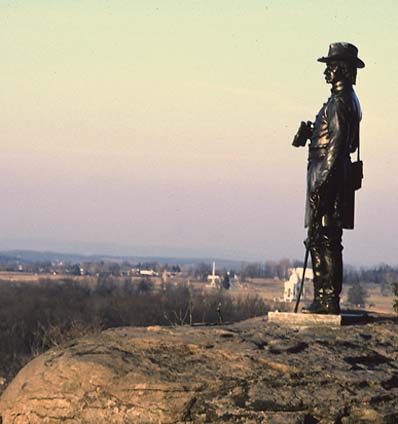 General G.K. Warren statute on Little Round Top
General G.K. Warren statute on Little Round Top
with Seminary Ridge in background (Dec 1994) |
June 1967, Dec 1986, Dec 1994, June 2022 |
2 |
Antietam
Antietam National Battlefield
Maryland

|
The
battle of Antietam (Sharpsburg to the South) on 17 Sep 1862 was the
single bloodiest day in American history. It ended Confederate General
R.E. Lee's first invasion of the North, and was a major tactical
victory for the Union, although Union General McClellan's failure to
follow up brought on his final dismissal. President Lincoln used the
victory to issue the Emancipation Proclamation and change the purpose
of the war. As a battlefield site there are many places to visit, from
the Cornfield, to Dunker Church, to the Sunken Road, to Burnside's
Bridge. There are many monuments and statutes to seek out, including
that of future President William McKinley carrying coffee to the front
line. The battle's impact places it first in importance in my rankings of Civil War battles.
On each anniversary candles are lit to
mark the 23,000 casualties, no doubt a dramatic sight to see. In my early visits
the battlefield site itself felt constrained. Its
smallish size is crowded with statues and markers. However, the Civil War Trust has added further acreage; the site now looks liess crowded; and recent visits sparked longer walks on newly-acquired land.
|
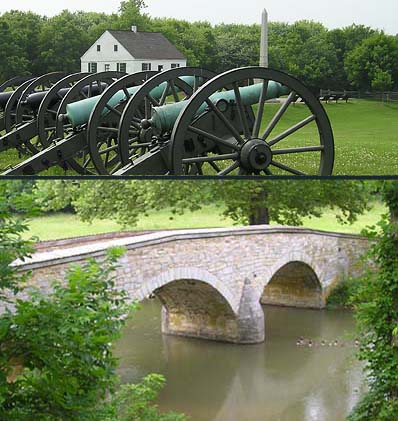 Dunker Church (top) and Burnside's Bridge (bottom) were both scenes of ferocious fighting (June 2009)
Dunker Church (top) and Burnside's Bridge (bottom) were both scenes of ferocious fighting (June 2009) |
June 1967, June 2009. June 2022 |
3 |
Pea Ridge
Pea Ridge National Military Park
Arkansas

|
This
7-8 Mar 1862 battle in nw Arkansas secured Missouri for the Union. This large park
preserves all the important sites of this sprawling battlefield. While
there are rows of cannon here and there, the landscape is mostly
preserved as it was in 1862. The site is thus
different in character than well-known eastern battlefields over-filled
with monuments. The interpretative materials (visitor center etc.) are excellent and one gets a real feel for the geography of the
battle. I highlight this "new style" battlefield because not only was
the battle important, but the interpretation is so excellent.
With
~25,000 troops involved, the scale of this battle is only 15% the size
of Gettysburg, but that makes it easier to
follow the strategy devised by Union general Samuel Curtis to defeat
the combined efforts of Confederate generals Earl Van Dorn, Sterling
Price, and Ben McCulloch. Interesting sidelights include the use of 3
Cherokee & Creek Indian regiments on the Confederate side. The overall visitor experience is just
superb. |
 Elkhorn Tavern, a central focus during the battle of Pea Ridge,
Elkhorn Tavern, a central focus during the battle of Pea Ridge,
with Don & Rita (March 1997) |
Mar 1997 |
4 |
Franklin
The Battle of Franklin Trust: Carter House & Carnton Plantation
Tennessee

|
The
Battle of Franklin, on 30 Nov 1864, was a full frontal assault by John
Bell Hood's Army of Tennessee against the Union barricades of Union
Gen. John Schofield at the little town of Franklin. At the time,
Sherman was marching south into Georgia after the fall of Atlanta; the
new Confederate General Hood tried to go north and retake Tennessee.
"The annals of war may long be searched for a parallel to the desperate
charge of the Army of Tennessee at Franklin, a charge which has been
called 'the greatest drama in American history'," wrote one author.
Five Confederate generals were killed in the failed assault and almost
a quarter of the rebel army lost.
The battlefield site has mostly been
lost to urbanization but a non-profit trust has preserved the Carter
House (at the center of the fight) and Carnton Plantation (where blood
from the wounded still stains the floors), and continues to add more
land to this endangered battlefield site. The museum at Carter House is
superb, and so are on-line resources, including an astonishingly good animated map on the Civil War Trust site.
|
 The Carter House,
riddled with bullet holes, still stands at the center of the
battlefield. During the battle the local family hid in the basement,
which can still be visited today (with Rita; March 1997)
The Carter House,
riddled with bullet holes, still stands at the center of the
battlefield. During the battle the local family hid in the basement,
which can still be visited today (with Rita; March 1997) |
Mar 1997, Dec 2002 |
5 |
Vicksburg
Vicksburg National Military Park
Mississippi

|
Vicksburg,
a commercial port on the east bank of the Mississippi River, was they
key to Union victory in the West. Indeed, one recent history of the
campaign is entitled simply: Grant Wins the War: Decision at Vicksburg.
General U.S. Grant did so by running gunboats past the batteries of
Vicksburg at night, marching his army down the west bank and crossing
below Vicksburg on 30 Apr 1863, and winning battles at Jackson and
Champions Hill, bottling up Confederate General Pemberton's army in
Vicksburg. The town fell and the rebel army surrendered after a 2-month
siege on 4 July 1863. It was Grant's most brilliant victory.
The
battlefield site is long and narrow, following the siege lines, and is
filled with many statues and markers. What sets this site apart was the
recovery and reconstruction of the Union gunboat Cairo. One
of 7 Union ironclads, it was sunk during the campaign. Its hulk was
discovered in 1956 but not recovered until Congress allocated funds in
1977. Today, the gunboat can be viewed at close range, and its museum
has recovered artifacts along with excellent interpretation of its part
in the battle, its discovery, and its recovery.
|
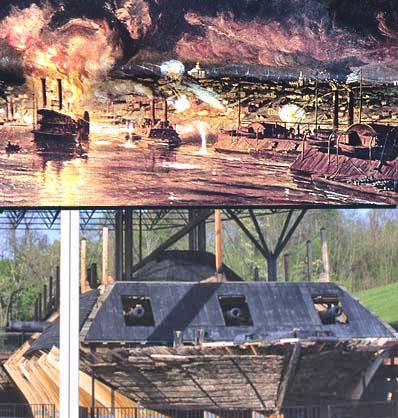 Union gunboats run the gauntlet past Vicksburg on the night of 16 Apr 1863 (art from a 1960s edition of Life magazine, top); recovered & reconstructed gunboat Cairo today (March 1997)
Union gunboats run the gauntlet past Vicksburg on the night of 16 Apr 1863 (art from a 1960s edition of Life magazine, top); recovered & reconstructed gunboat Cairo today (March 1997) |
June 1967,
Mar
1997 |
6 |
Perryville
Perryville Battlefield State Historic Site
Kentucky

|
The
confused fight at Perryville was perhaps the second-most important battles of
the Civil War. It ended Confederate General Braxton Bragg's invasion to
regain Kentucky for the South. With the victory on 8 Oct 1862, Kentucky would remain in the Union for the rest of the war.
The battle was fought by Union Gen. Don
Carlos Buell's Army of the Ohio, but Buell did not even know it
happened until it was over. It was the tenacious heroism of many
smaller Union units that saved the day. Bragg would thereafter retreat
all the way to southern Tennessee.
Yet the
battle is little known, under-appreciated, and the site is not even
federal property. Rather, the state of Kentucky maintains an
exceptionally fine and well-interpreted battlefield. The Civil War Trust has added more acreage after our visit. It is in the "new
style" – very few statues or monuments but well-maintained woods and
fields – so that one feels a part of the environment. There were many interpretive walks to take. Alas, during our
Christmas Day visit, the museum and visitor center were closed. I must visit again.
|
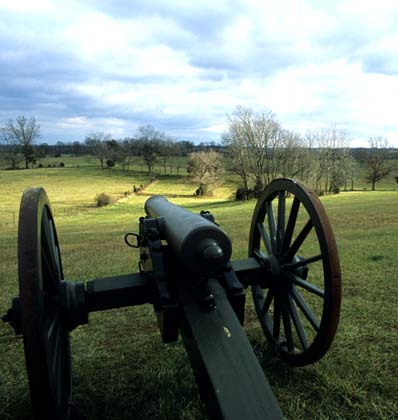 Approaching storm at Perryville Battlefield (Dec 2002)
Approaching storm at Perryville Battlefield (Dec 2002) |
Dec 2002 |
7 |
Shiloh
National Military Park
Tennessee

|
At
the time it occurred on 6-7 Apr 1862, Shiloh was the biggest battle
every fought in America. General U.S. Grant's army was encamped near
Pittsburg Landing on the Tennessee River when General Albert Sydney
Johnston's Confederates launched a surprise attack. He was hit in the
leg during the attack and bled to death before his aides understood
what was happening. General P.G.T. Beauregard inherited the rebel
attack. They almost pushed the northern troops into the river the first
day, but Grant organized a late-afternoon stand. The next day, with new
forces arriving from across the river, Grant counter-attacked and
retook the field. Losses were astonishing: about 14,000 casualties of
~103,000 men engaged (a 23% casualty rate).
The
battlefield drive takes one to famed sites like the Peach Orchard, the
Hornet's Nest, and Bloody Pond. The landscape is heavily wooded, and
the primary battle locations must constantly be cleared of new growth
to give any sense of the circumstances. This is a classic site covering
an exceptionally important early battle in this national conflict.
|
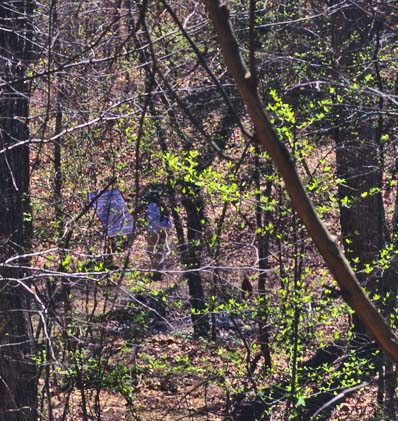 woods near site of Gen. A.S. Johnston's death; Rita at interpretive sign in background (Mar 1997)
woods near site of Gen. A.S. Johnston's death; Rita at interpretive sign in background (Mar 1997) |
June 1967, Mar 1997 |
8 |
Appomattox
Appomattox Court House National Historical Park
Virginia

|
In
traditional lore the Civil War ended when Lee surrendered to Grant at
Appomattox Court House on 9 April 1865. There were other Confederate
armies still fighting, most notably that of Gen. J.E. Johnston in North
Carolina, and the Confederate government still at large, but it is fair
enough to say that the entire world saw Lee's surrender as the end of
the war. There are many interesting stories associated with this
surrender apart from the contrast in styles and dress of Gen. Lee and
Gen. Grant. Among them is the story of the McLean family, whose home in
1861 was at Manassas -- and they moved here to get away from the War!
As the narrator in Ken Burns' Civil War series says of Mr. McLean: "The war started in his back yard and ended in his front parlor."
When
I visited here as a teenager, one could park right next to the site.
Today, the entire small village of Appomattox Court House is preserved
and visitors park some distance away, giving a much better period feel
to the experience. |
 Front porch of McLean House
Front porch of McLean House
at Appomattox Courthouse (Dec 1994) |
June 1967, Dec 1994 |
9 |
Ft. Sumter
Ft. Sumter National Monument
South Carolina

|
The
American Civil War began with the rebel firing on Ft. Sumter on 12
April 1861. Ft. Sumter was a pentagonal fort of brick construction on a
artificial island in the middle of Charleston's main ship channel. The
bombardment lasted 34 hours before Maj. Robert Anderson surrendered the
fort. No federal soldiers were killed but the fort was badly battered.
The first Union casualty came during an accidental explosion during a
ceremonial surrender salute.
Fort Sumter sits in a
dramatic location, and is today visited by boat. The Fort is
well-preserved and interpreted. One may also visit sites on the
mainland, including Ft. Moultrie, which Anderson had abandoned on the
night of 26 Dec 1860 to withdraw to Ft. Sumter. Rebel forces used it to
bombard Sumter in April. [Additional battle sites around Charleston can
be visited, including the site of Battery Wagner, detailed separately
in this web project.] |
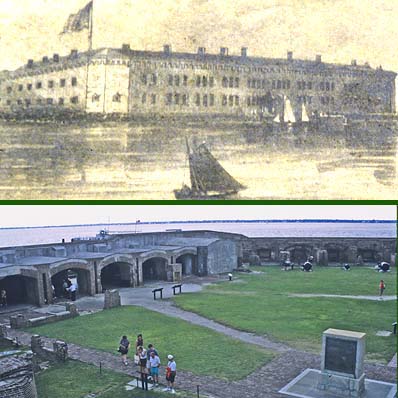 Ft. Sumter (top) in a painting from 1861 (on a sign in the park)
Ft. Sumter (top) in a painting from 1861 (on a sign in the park)
and interior of Ft. Sumter today (bottom; Aug 1997) |
Mar 1997 |
10 |
Harpers Ferry
National Historical Park
West Virginia

|
With
Maryland on one side, and Virginia on the other, the West Virginia
point of land at the confluence of the Shenandoah & Potomac Rivers
is the little town of Harpers Ferry. In the 1850s it was important as a
U.S. munitions factory & armory. John Brown's raid on the U.S.
Armory in 1859 alarmed the South, and help lead to the Civil War.
"Stonewall" Jackson led Confederate divisions to capture Harpers Ferry
during the Sep 1862 Antietam campaign.
Today,
the entire old town is reconstructed and preserved. Visitors take buses
down into the town, where the fire station at which John Brown was
captured is restored. There is a superb museum on the John Brown raid,
its participants, and its impact. Another museum interprets the
historic town. Upslope is a preserved battlefield with good explanatory
signs and regular interpretive walks. Plus, amid all this, Harpers Ferry
is in an absolutely gorgeous location.
|
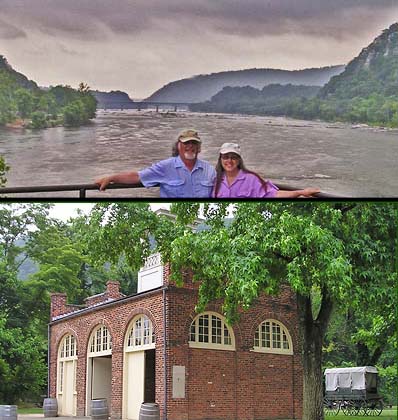 The
confluence of the Shenandoah & Potomac Rivers at Harpers Ferry
(with Don & Rita, top); firehouse where John Brown was captured
(bottom; June 2009) The
confluence of the Shenandoah & Potomac Rivers at Harpers Ferry
(with Don & Rita, top); firehouse where John Brown was captured
(bottom; June 2009) |
June 1967, Sep 1985, June 2009 |
|
RECOMMENDED BOOKS & MEDIA :
1. Battle of Gettysburg
- Media: The 4-hour 1993 movie Gettysburg,
directed by Robert Maxwell, and starring Tom Berenger (as Longstreet),
Martin Sheen (as Lee), Jeff Daniels (as Chamberlain) and Stephen Lang
(as Pickett), is outstanding and goes a long way in rebuilding
Longstreet's long-tarnished reputation. We often watch it again
on or about each July 4th as an anniversary commemorative of the battle
and the Civil War. It was more fun to later buy the director's cut and
see all the "extras" about the making of the movie.
- Books: There are too many books to mention, including H.W. Pfanz's authoritative volumes on the first two days,
but I especially enjoyed Stephen Sears' (2003) Gettysburg, Carol Reardon's (1997) Pickett's Charge in History & Memory, and Wittenberg & Petruzzi's (2006) Plenty of Blame to Go Around: Jeb Stuart's Controversial Ride to Gettysburg.
2. Battle of Antietam
- Media: The director's cut of the 2003 movie Gods & Generals
was released in May 2011.
The extended version is 6 hours long -- adding 1.5 hours from the
original release -- but it includes a filmed version of the Battle of
Antietam t. A review of the original 2003 film
is discussed under Chancellorsville, later in these web pages.
- Books: Stephen Sears' (1983) Landscape Turned Red: the Battle of Antietam is a little dogmatic and a bit dated; the essays in editor Gary Gallagher's (1999) The Antietam Campaign help add perspective.
3. Battle of Pea Ridge
- Books: William L. Shea & E.J. Hess's (1992) Pea Ridge: Civil War Campaign is the West is an outstanding history of the campaign and the battle, with good maps and period photos.
4. Battle of Franklin
- Media: An astonishingly good animated map is on the Civil War Trust site, which also has extensive information on attempts for battlefield preservation.
- Books: There are two exceptional books to read. James Lee McDonough & Thomas L. Connelly's (1983) Five Tragic Hours: the Battle of Franklin focuses directly on this fight, and has a nice set of photos of places and personalities. Wiley Sword's (1994) Embrace an Angry Wind: Spring Hill, Franklin, and Nashville
covers Hood's final campaign. It has good maps, a fine set of photos
printed on glossy paper, and delves into Spring Hill as well as
Franklin. Also, Thomas L. Connelly's (1971) Autumn of Glory,
volume 2 of his history of the war in Tennessee & Kentucky, has a
lengthy discussion of Spring Hill and the battles of Franklin and
Nashville. Finally, an understanding of Franklin requires an
understanding of John Bell Hood, and I found Richard M. McMurry's
(1982) John Bell Hood and the War for Southern Independence a good exposition of that topic.
5. Battle of Vicksburg
- Books: James Arnold's (1997) Grant Wins the War: Decision at Vicksburg
is a fast-paced history of the entire Vicksburg campaign, including
details of the battles of Jackson and Champions Hill. The latter served
to bottle up Pemberton's army in Vicksburg for the inevitable siege,
and is arguably one of the most important battles of the war. Bruce
Catton's (1960) Grant Moves South is still a classic history of Grant's entire 1861-1863 western campaign that culminated in the victory at Vicksburg.
6. Battle of Perryville
- Books: Kenneth W. Noe's (2001) Perryville: This Grand Havoc of Battle
is an unexpectedly wonderful account of this pivotal battle, with maps
and photos, some old and some current. It follows up on James Lee
McDonough's classic (1994) War in Kentucky: from Shiloh to Perryville,
which covers the campaigns leading to Perryville (with only a third of
the book on Perryville). Earlier, Thomas L. Connelly's (1967, 1971)
two-volume history of the Army of Tennessee [Army of the Heartland, Autumn of Glory] provided an overview of the entire war in Tennessee & Kentucky from the Confederate perspective.
7. Battle of Shiloh
- Books: Larry J. Daniels' (1997) Shiloh: The Battle that changed the Civil War, is a fine battle history with detailed maps and period photographs. Wiley Sword's earlier (1974) Shiloh: Bloody April is perhaps more engaging in writing style, and both are heavily foot-noted. Bruce Catton's (1960) Grant Moves South
is still a classic history of Grant's entire 1861-1863 western
campaign, while Thomas L. Connelly's (1967, 1971) two-volume history of
the Army of Tennessee [Army of the Heartland, Autumn of Glory] is a fine overview of the entire war in Tennessee & Kentucky from the Confederate perspective.
8. Appomattox Court House
- Books: The truth is that I have not yet read the portions of the two books I have in my library that cover the surrender: Chris Calkins' (1997) The Appomattox Campaign: March 29-April 9, 1865 [a colorful account of the campaign by the recognized authority on the topic] and Richard Wheeler's (1989) Witness of Appomattox [a popularized account without footnotes and presumably without any
original research]. Of course, all the major series on the Civil War
have detailed descriptions of the surrender. These include Bruce
Catton's (1965) Never Call Retreat, the final volume of his centennial history of the Civil War; Allan Nevins' (1971) The War for the Union: Organized War to to Victory, 1864-1865, the 4th volume in his Civil War series and the 8th in his history of mid-19th century America; and Shelby Foote's (1973) The Civil War: a Narrative (Red River to Appomattox), the final volume in his lively trilogy.
9. Ft. Sumter
- Books: Robert Hendrickson's (1990) Sumter: the First Day of the Civil War is a decent account, with many period photos and some contemporary
appendices of interest, but is not a foot-noted history. Of course, all
the major multi-volume series on the Civil War give significant
attention to Ft. Sumter. Ivan Musicant's (1995) Divided Waters: the Naval History of the Civil War also has a pertinent chapter.
10. Harpers Ferry Historic Site
- Media: I haven't yet seen a movie featuring Harpers Ferry as a subject, but if you watch the 2003 movie Gods & Generals
(reviewed under Fredericksburg & Chancellorsville later in these
web pages), it is worth keeping in mind that the parts of the Battle of
Fredericksburg that show fighting in the town of Fredericksburg were,
in fact, filmed at today's Harpers Ferry.
- Books: I don't have a specific book on Harpers Ferry. Stephen Sears' (1983) Landscape Turned Red: the Battle of Antietam covers the Sep 1862 battles there. I also have Stephen B. Oates' (1970) To Purge This Land with Blood: a Biography of John Brown,
and will read it with interest some day. New information on John
Brown's raid is in letters edited by Hannah N. Geffert in "When the
Raiders Came," Columbiad 4: 109-121 (2000).
|
or the choices via links at right:
|
|
|
|
|

















